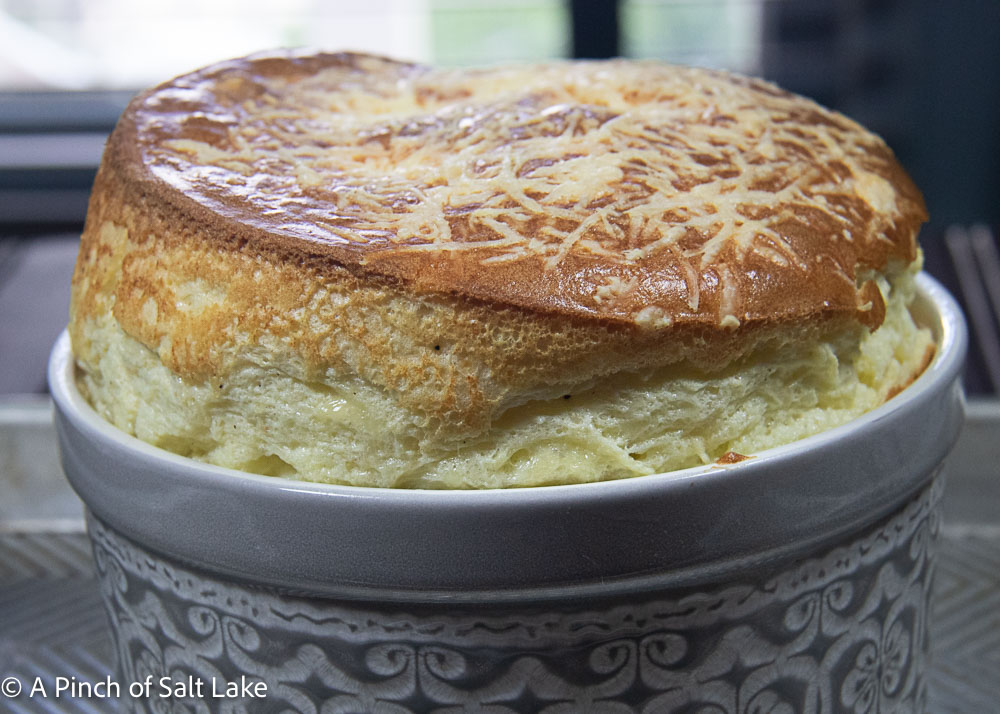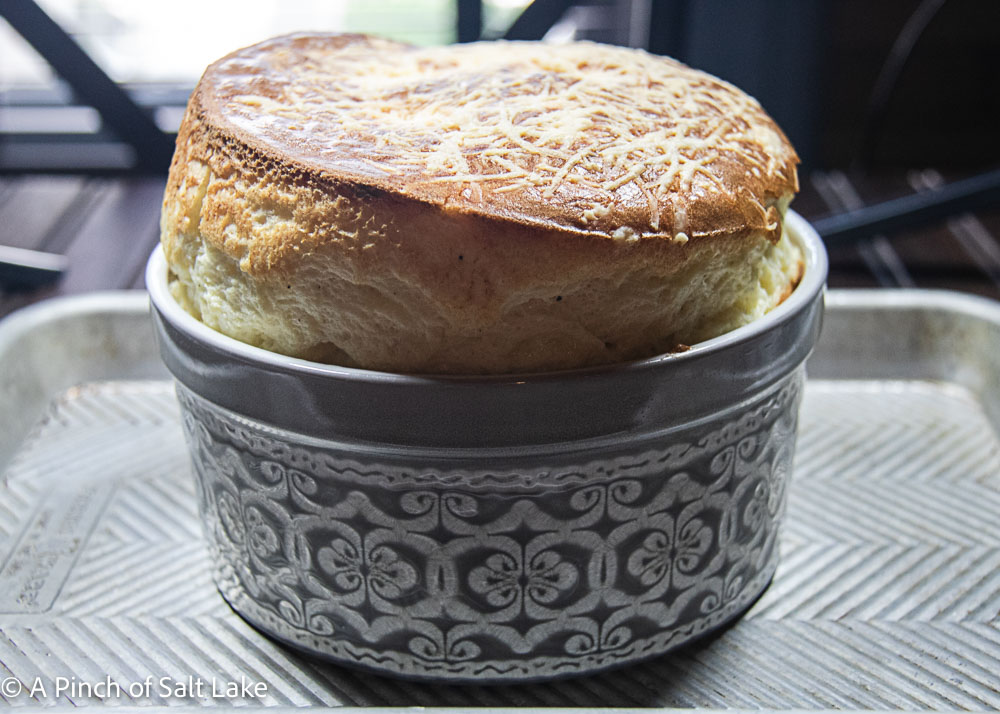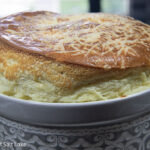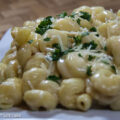
Gruyere Cheese Soufflé is such an impressive dish. However, this classic dish is also full of cheesy goodness. A golden puff that is perfect for lunch or dinner. Don’t be scared off by the heated egg cheese sauce or whipping the egg whites to stiff peaks. Take each step in turn and you will be enjoying a beautiful Gruyere cheese souffle in less than an hour.
Gruyere and Parmesan Cheese

Gruyere cheese is a wonderful hard type of Swiss cheese made from cow’s milk. Named after a town in Switzerland that first made it, the taste is a uniquely rich, and slightly nutty flavor profile that melts wonderfully into a creamy lusciousness.
It is equally at home on a cheeseboard, (one of my favorite cheeses) the sharp bite pairs with dried fruit, as well as being a star melting cheese.
Pair gruyere cheese with Parmesan cheese for a wonderful contrast. Use a parmesan cheese that you grate yourself for the best taste. Check out this post for more information about cheese and making a cheese sauce.
Tips for a Glorious Gruyere Cheese Soufflé

- Use a tall round soufflé dish. The shape of the dish helps the soufflé rise up and form the classic poof. This recipe is perfect for a 1-1/2 quart soufflé dish. You can also make individual soufflés. Look for dishes that are 2-1/2” round.
- Grease the dish well and then sprinkle with a scan amount of grated parmesan. This step helps the soufflé climb the sides, brown up nicely as well as adds to the cheese flavor.
How to Separate Egg Yolks from the Egg Whites
Separate the egg whites from the yolks. Use three bows—crack each egg over bowl one and use the shell to let the egg white collect in. When only the yolk is left in the shell, pour it into bowl two. Make sure no yolk is in bowl one before you pour the egg white into bowl three. Repeat until all the eggs have been separated.
- Be so careful to make sure no yolk gets in the whites, even a scant amount of yolk will keep the whites from whipping into stiff peaks.
- Oil (whether from the egg yolk) or from residue will prevent the eggs whites from incorporating air. You can wipe down the beaters as well as the bowl with a dish towel dipped in white distilled vinegar to neutralize any oil.
- Once the roux has thickened the base, take the pan off the heat and stir in the cheeses.
- Incorporate a spoonful of the egg whites into the warm cheesy base to temper it. Check out this post for more information.
Filling and Baking a Souffle
- Fill the soufflé dish to 1” below the rim, you can run the tip of a knife around the soufflé base about 1” in from the edge. This helps create a beautiful dome.
- To prevent any overflow from making a mess in the oven, place the soufflé dish on a baking sheet.
- Don’t open the oven door while the soufflé is baking to prevent the soufflé from collapsing.
- Cook until the center is golden brown and has risen into a beautiful poof. If you are unsure if the gruyere cheese soufflé is fully cooked, check the center with an instant-read thermometer for the interior to register 170 degrees.
- The soufflé will begin to deflate when it is removed from the oven. So have everything ready to eat as soon as it is done.

Gruyere Cheese Souffle
- Prep Time: 15 minutes
- Cook Time: 22-25 minutes
- Total Time: 0 hours
- Yield: 6 servings 1x
- Category: Entree
- Method: stovetop, baked
- Cuisine: American, French
- Diet: Vegetarian
Description
Gruyere Cheese Soufflé is an impressive main dish that is warm and full of cheesy goodness.
Ingredients
- 4 eggs, separated
- 2 tablespoons butter
- 2 tablespoons flour
- 1–1/3 cups milk
- 6 ounces gruyere cheese, freshly grated (about 1 cup)
- 4 ounces Parmesan cheese, freshly grated (about 1–1/4 cups) divided
- 1/2 teaspoon white pepper
- Pinch of cayenne pepper
- 1/2 teaspoon cream of tartar
- Freshly grated nutmeg
Instructions
- Preheat the oven to 400°F. Grease a 1-1/2 quart soufflé dish well. Sprinkle a tablespoon of grated parmesan cheese around the sides and bottom of the greased dish. Set aside.
- Separate the egg yolks and whites, and set aside.
- În an medium saucepan over medium-high heat, melt the butter.
- Whisk in the flour and cook for 2-3 minutes to form a pale roux.
- Warm the milk in the microwave for 30 seconds and stir to evenly distribute the heat.
- While whisking continuously, slowly pour the warmed milk. (The warmed liquid and even whisking will help prevent lumps from forming) into the roux until incorporated and thickened. Continue stirring for 3-5 minutes.
- Lower the heat to low and gently whisk in the egg yolks, one at a time, making sure the yolk has been incorporated into the base before adding the next one. Make sure you are stirring continuously to avoid scrambling the egg yolks.
- Remove the pan from the heat, and gradually stir in the mixture of cheeses, a handful at a time until all the cheese has melted and the sauce is thick and creamy.
- Stir in the grated nutmeg, white pepper, and pinch of cayenne pepper. The cheese base will be highly seasoned at this time because the egg whites will mellow the seasoning.
- Set aside to let cool slightly while you whip the egg whites.
- Using carefully cleaned beaters and a bowl. Whip the egg whites and cream of tartar together until they are light with air and form stiff peaks.
- Gently stir a spoonful of whipped egg whites into the cheese mixture to temper it, then carefully fold the rest of the egg whites into the cheese base with a spatula.
- Carefully spoon the soufflé mixture into the prepared souffle dish.
- Run the tip of a knife around the edge of the soufflé about an inch from the edge to help the soufflé poof up.
- Place the filled soufflé dish on a baking sheet. Transfer the baking sheet to the preheated 400°F oven for 15 minutes. Then without opening the oven door, reduce the oven temperature to 350°F and continue baking for 10-13 minutes more until the soufflé has risen and the poof is a deep golden brown.
- Remove the soufflé from the oven and serve immediately.
Notes
If you are unsure if the gruyere cheese soufflé is fully cooked, check the center with an instant-read thermometer for the interior to register 170 degrees.






Leave a Reply